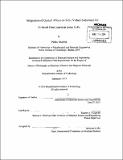Integration of GaAsP alloys on SiGe virtual substrates for Si-based dual-junction solar cells
Author(s)
Sharma, Prithu
DownloadFull printable version (10.87Mb)
Other Contributors
Massachusetts Institute of Technology. Department of Materials Science and Engineering.
Advisor
Eugene A. Fitzgerald.
Terms of use
Metadata
Show full item recordAbstract
Integration of III-V compound semiconductors with silicon is an area that has generated a lot of interest because III-V materials and Si are best suited for different types of devices. Monolithic integration enables the best material to be chosen for each application, enabling new functionalities with the potential of additional miniaturization on a system level. Integration of GaAsP alloys on Si substrates would enable the creation of high efficiency dual-junction solar cells on low cost and light weight Si wafers and would also enable a path for yellow and green light emission devices on a Si platform. Our work focused on the materials integration problems for multiple pathways to integrate GaAsP alloys on Si substrates. We first addressed the direct integration of GaAsP alloys on Si substrates. Our results showed that despite the low lattice-mismatch conditions at the P-rich end of the GaAsP alloy spectrum, it was difficult to achieve thin films low defect density. We proceeded to focus on the integration of GaAsP alloys on Si via the use of SiGe compositionally graded layers. Through a combination of methods we addressed problems related to antiphase disorder and lattice mismatch between GaAsP and SiGe materials system. We demonstrated the epitaxial growth lattice-matched GaAsP on Si₀.₈₈Ge₀.₁₂, Si₀.₅Ge₀.₅, Si₀.₄Ge₀.₆ and Si₀.₃Ge₀.₇ virtual substrates with excellent interface properties. Our studies showed the effects of initiation conditions and intentional strain at the GaAsP/SiGe heterovalent interface. We have established strain-engineering methods at the GaAsP/SiGe heterovalent interface to prevent dislocation loop nucleation and expansion. We were able to attain GaAsP films on Si with a threading dislocation density as low as 1.2x10⁶/cm² . Our GaAsP/SiGe heterovalent interface research advanced the understanding of such structures. We developed methods to fabricate optimized GaAsP tunnel junction film, which would be necessary for any current-matched dual junction solar cell design. Prototype dual-junction GaAsP/Si solar cell test devices showed good preliminary performance characteristics and offer great promise for future devices integrated with the newly developed high quality GaAsP/Si virtual substrates.
Description
Thesis: Ph. D., Massachusetts Institute of Technology, Department of Materials Science and Engineering, 2013. Cataloged from PDF version of thesis. Includes bibliographical references (pages 117-122).
Date issued
2013Department
Massachusetts Institute of Technology. Department of Materials Science and EngineeringPublisher
Massachusetts Institute of Technology
Keywords
Materials Science and Engineering.